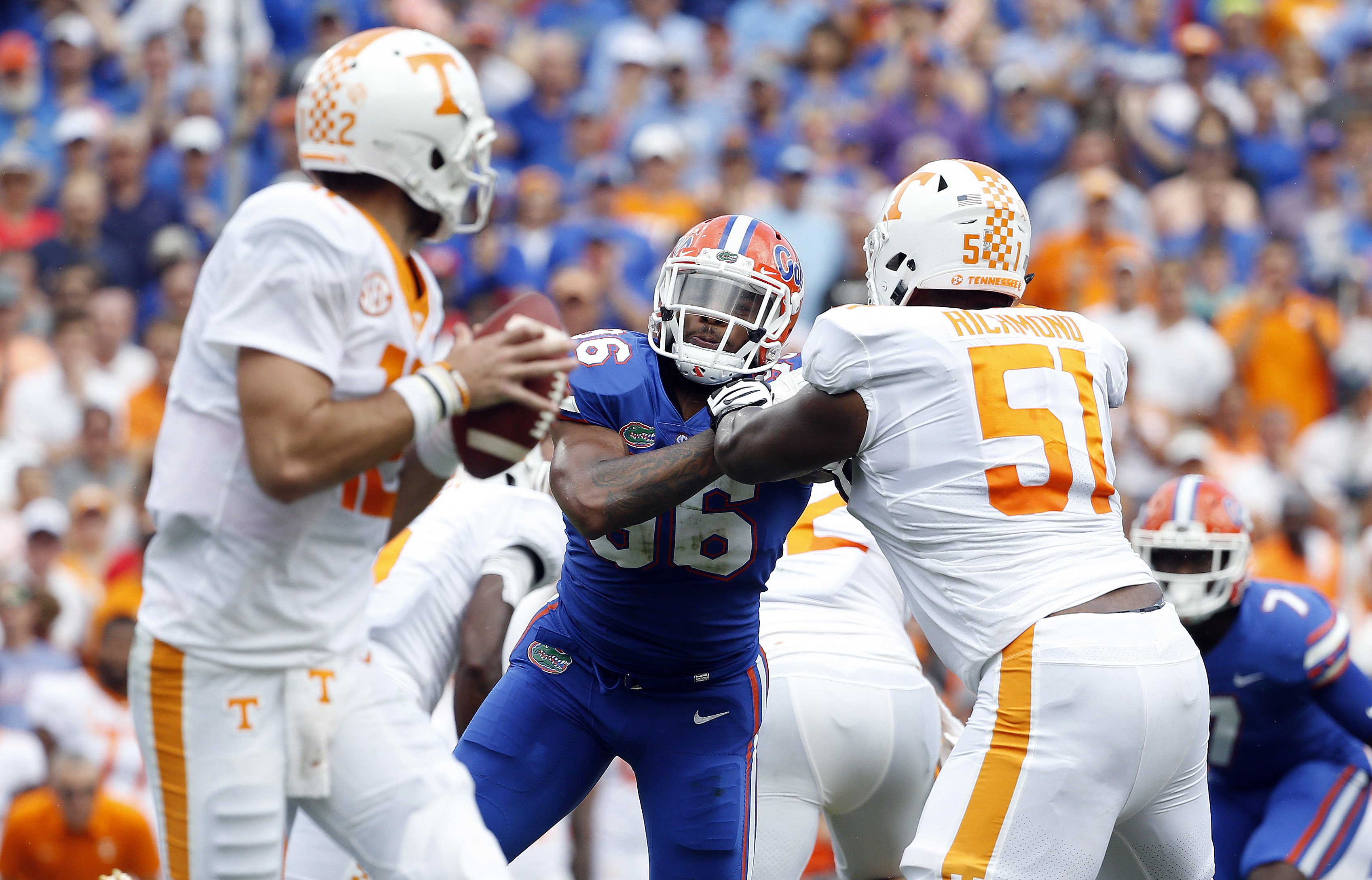
Film review: Florida’s defensive line is doing the heavy lifting
By Ian Boyd
Published:
Jim McElwain’s Florida Gators have two SEC East division titles in two seasons despite struggling to find a QB or play winning offense in that stretch. They’ve been downright bad on offense during much of that time and appear to be pretty iffy on that side of the ball again this year.
Their defense, which ranked 4th in S&P+ in 2016, was facing a tall order trying to carry the team in 2017 after losing nearly the entire defensive front and having to plug in freshman cornerbacks when playing its nickel package.
Despite those challenges, the Gators are 1-0 in SEC play with a key victory over East rival Tennessee. The reason for that success has a lot to do with a defensive line that is essentially carrying the water for the whole team.
Preferred strategies
Florida’s defensive strategies straddle the line between “aggressive” and “cautious,” with a tendency to play two-deep coverages and match three-receiver sets with nickel personnel — but paired with press coverage and an attacking style up front.
Here’s an example of the Gators’ base defense at work against a standard offensive formation (one RB, one TE, three WRs):
http://www.giphy.com/gifs/l1J9vDLrH0iesyyJy
They use a four-man rush from the DL, the LBs are monitoring the TE and the RB in the backfield while dropping into shallow zone, the CBs are playing press coverage but with safety help on the inside on both ends of the field.

Because they have good athletes in the secondary, they can afford to play a lot of press coverage and protect it with pretty deep safety alignments. The safeties cover a lot of ground coming up to support the run, and they get a lot out of playing tight coverage over the receivers behind this defensive line.
The key is that the defensive line doesn’t get gashed too badly and force the spread-out secondary to have to try to clean up plays against runners working in open grass. The linemen tend to achieve that and more with aggressive techniques that regularly protect the rest of the defense from blockers. It’s a classic 4-3 defensive approach not too far removed from what DC Randy Shannon played and then taught at the University of Miami in the 1980s and 90s.
Here’s DE Cece Jefferson blowing up a Michigan power run by pinching inside and working off the TE block before also hitting the pulling guard before the guard can find a linebacker — and then even working off that block as well.
http://www.giphy.com/gifs/xT9IgqSfqgPYDG4QNO
Now here they are working against the split zone play that gave Alabama trouble from Colorado State the other week.
http://www.giphy.com/gifs/3o7aCVU5TUzZAJNogU
The DE is looking to contain the ball inside this time while the two DTs command the attention of all three interior OL without giving up ground or gap, and the LBs fire downhill behind them. The free safety and nickel are coming in run support, but they’re just there to clean up if the ball slips out; there’s no one blasting out of these gaps.
Finally, on perhaps the most challenging play for DEs to handle, the counter play with a guard kicking that player out:
http://www.giphy.com/gifs/3ohhwl9nlRkXysk25y
Florida has a rare blitz on for this play but that hardly matters. The DE blows up the pulling guard and then pops the RB and brings him down for a major loss.
Teams love to attack DEs on these sorts of run plays because 4-3 defenses like to choose top athletes to play the position in order to create a good, base pass-rush. The Gators’ DEs and DL in general are not particularly vulnerable to these schemes, and they are still good at getting push in the pocket.
http://www.giphy.com/gifs/xT9IgrwNAjCnP8H1Ty
Sometimes they use twists and stunts up front, sometimes they just use a pure rush, but in conjunction with their press coverage and two-deep coverages they tend to get home pretty often.
Production
The Gators have six sacks in their two games, with all six coming from defensive linemen. They do blitz a fifth man now and again, but they’ve been able to be very productive rushing the passer so far without taking many risks.
Opponents are averaging 4.85 yards per carry on the ground against the Gators, and the only two teams they’ve played are Michigan and Tennessee, two of the better rushing teams in the country. That number is going to plummet over the course of the year.
Florida had to start over across their defensive front after losing two starting linebackers, two defensive tackles and three defensive backs to the NFL draft. They’re just chugging along, though, under Shannon, plugging in fresh Florida kids schooled in DL techniques that led to dominant defenses in the 80s, 90s and today.
Ian Boyd is a college football analyst who studies the strategies and tactics across the game. Follow or contact Ian on twitter @Ian_A_Boyd.







